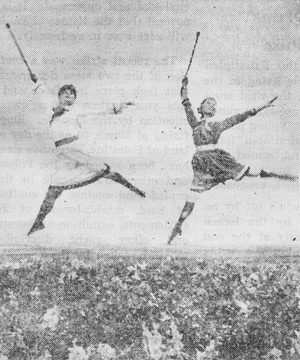|
 |
|
A scene from Sons and Daughters of the Grassland |
The dance-drama Sons and Daughters of the Grassland has been a big hit throughout China, particularly among the youngsters and children. This is because of its revolutionary political content and rich dance idioms, its vividly expressive and graceful movements.
The main characters are two youngsters of China's Mongolian nationality, Temur and his younger sister Schin, whose fine revolutionary qualities - courage, tenacity and wholehearted devotion to the public interests - are highlighted in the dance-drama.
The scene is the pasturelands of the Inner Mongolian Autonomous Region in China's northern frontier.
Early one morning when the first rays of the sun are lighting up the sky, Temur, Schin and some other herdsmen begin a new day's work in a joyous atmosphere. Seeing the bustling activity on the pastures which he once owned, the reactionary herd-owner Bayan who dreams of a counter-revolutionary restoration lashes with his whip at the sheep belonging to the people's commune in a fit of fiendish frenzy. Bayan's reactionary behaviour is exposed and severely criticized by Temur and his sister.
Later while the two youngsters are out grazing the sheep, they are caught in a sudden blizzard. Frightened by the howling wind and swirling snow, the sheep scatter. Fighting against the blinding snowstorm to protect the sheep, they finally succeed in driving them to a pen. One of the lambs is lost, and after they set out to look for it, Bayan sneaks up in the dark, flings open the door of the pen and stampedes the flock.
On their return, the two youngsters find a knife sheath outside the pen and realize that there has been a deliberate sabotage by Bayan. Taking the sheath with them, they go after the sheep in the teeth of the snowstorm, totally disregarding their own safety.
On the vast blizzard-swept grasslands, they protect the commune's flock with great determination, regardless of hunger, severe cold and fatigue and displaying revolutionary optimism and revolutionary heroism in the face of difficulties.
Before long Bayan catches up with them and tries to take back the sheath so as to get rid of the evidence of his crimes. Courageously, the two youngsters fight the reactionary herd-owner with bare hands.
Meanwhile, some herdsmen and PLA (People's Liberation Army) patrols are anxiously searching for the two little heroes. After a whole day and night's search, they finally come to the rescue of Temur and Schin, while Bayan receives his well-deserved punishment.
In creating this dance-drama, the scriptwriters were probably inspired by what had really happened in the Inner Mongolian Autonomous Region on February 9, 1964. On that day, 11-year-old Lungmei and 9-yearold Yujung, two sisters of Mongolian nationality, battled against a blizzard for 24 hours on end to protect the sheep of their people's commune. For this they were awarded the title of honour - the "heroic little sisters on the grasslands," But the typical images of the two youngsters in the dance-drama give expression to the fine qualities of the youngsters and children in China today.
The dance-drama embodies the salient features of our age and the characteristics of the Mongolian nationality and the younger generation.
The spirit of our time as shown in socialist literature and art finds concentrated expression in the proletarian heroes in literary and art works who are a new generation of people determined to make a clean break with the concept of private ownership. Temur and Schin are typical examples. In China today, the younger generation is nurtured by Marxism-Leninism-Mao Zedong Thought since childhood and therefore is capable of waging struggles selflessly and dauntlessly against class enemies and against any kind of difficulty.
This dance-drama which mirrors the life and struggle of the Mongolians adopts the movements of classical ballet as well as those of the Mongolian folk dance. This accounts for its distinctive national flavour.
It fully brings out the wisdom, strength and enthusiasm of the two little heroes. By executing healthy and graceful dance movements, Temur and Schin are like two eaglets gliding and swallows darting across the sky. The movements depict both the personality of heroes and the characteristics of children. Lovely and moving, their images have a strong impact of intimacy on the young theatre-goers.
An outstanding literary work for youngsters and children, this dance-drama ranks with the model revolutionary ballets The Red Detachment of Women, The White-Haired Girl and Ode to the Yimeng Mountains. | 